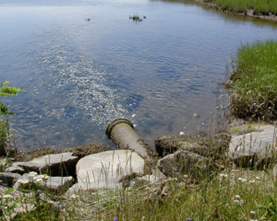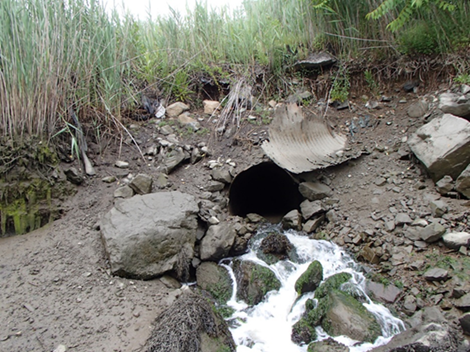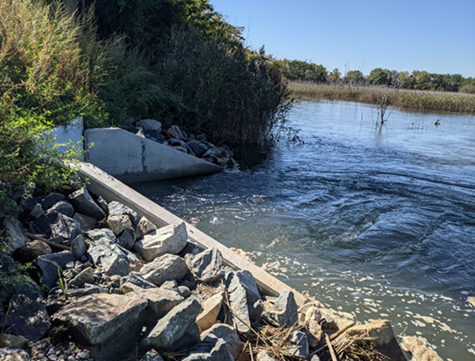Tidal Restoration

Buzzards Bay salt marsh impacts
Coastal wetlands are made up of tidal marshes and intertidal habitats (mud flats, sandy beaches, and rocky shores) found along rivers and estuarine.
Tidal wetlands are among Massachusetts' most valuable natural resources. Often called the ocean's farmlands, coastal wetlands provide the foundation of a detritus-based food web that supports coastal fish and bird species. Tidal flushing in these wetlands creates a productive environment that provides food and habitat for many creatures. When these wetlands can no longer access the saltwater of the ocean, there are major impacts to ecosystems that they support.
The photo on the right shows a salt marsh in Buzzards Bay, harmed by transportation related facilities such as roads, causeways, and footpaths. These restrictions changed the wetlands by reducing tidal exchange in the upper sections of the system and affecting the health of a salt marsh by decreasing its salt levels. MassDOT evaluates the potential for tidal restoration early on in a project's design, to avoid detrimental impacts to these resource areas.
Salt Marsh Restoration
The main goal of salt marsh restoration is to return a marsh's tidal flows and chemistry to its natural, pre-restricted conditions. Full restoration can be done by removing the restrictive feature or by creating an opening big enough to pass full tidal flows. Where bridges and culverts are too small to pass the full Spring tide, installing new culverts that are correctly sized and positioned will restore tidal range and proper salinity.
Culvert Replacement at Crescent Marsh to restore tidal flow to a 23-acre former salt marsh
In Saugus, we replaced a failed culvert under a road that reduced tidal flushing to Crescent Marsh. Crescent Marsh was connected to Bear Creek Estuary by a 48-inch-wide metal pipe culvert. Collectively, Bear Creek Estuary and Rumney Marsh are an undisturbed estuary and marsh complex. This area belongs to one of the most extensive salt marsh systems in the greater Boston metropolitan area. Crescent Marsh gets freshwater inflow from stormwater discharges, including MassDOT-owned stormwater outfalls like the failing culvert. Replacement of the culvert will enhance tidal flushing to 22 acres of salt marsh degraded by expansion of invasive species. Restoring the flushing of salt water will naturally control the invasive species and benefit native salt marsh grasses.

Before: The Crescent Marsh had a compromised narrow, metal culvert which threatened a fragile salt marsh habitat. The restricted tidal flow allowed the marsh to become invaded by freshwater invasive plant species, which reduced the biodiversity and integrity of the wetland.

After: To restore the salt marsh, MassDOT installed a larger 6-foot concrete box culvert, which has allowed salt water to access Crescent Marsh again. The wetland is expected to restore itself naturally.